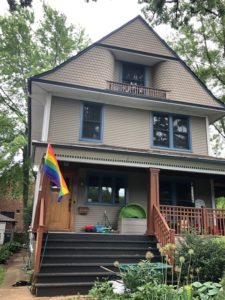 When I get together with my friend who lives near the Wisconsin border, we try to think of a place in between where we can meet and an activity we can enjoy together.
When I get together with my friend who lives near the Wisconsin border, we try to think of a place in between where we can meet and an activity we can enjoy together.
Usually, that means a lecture at a suburban library or a nice walk through the Chicago Botanic Garden or a couple hours enjoying the cool air and comfy seats of a mall-anchoring cineplex.
For our most recent get-together, she came up with something new; a “local legends” tour, sponsored by the Wilmette Historical Museum. It featured a smart phone enabled commentary on people who spent part of their lives in the north suburban community.
I had to laugh at myself, being of an age where I loved walking neighborhoods and actually knew most of the “legends” whose childhood homes were on the map.
The audio tour included bios and bits about actors Hugh O’Brien and Ralph Bellamy, illustrator Edward Gorey, and the man who invented processed cheese, James Lewis Kraft.
I took a photo of Charlton Heston’s boyhood home and contemplated driving by the modest residence of Ann-Margaret before heading back to the city, it being farther off the path where the other homes were clumped together.
I’ve toured the Alhambra in Granada, Spain and other world heritage sites. This was definitely simpler, without lines or crowds, and FREE. We were able to walk at our own pace. The audio recording worked well. It was a lot of fun.
I enjoy having something specific to see with no time constraints.
I love seeing something new or seeing something familiar in a new way.
I love being a tourist.
I’ve gone on architectural tours in Chicago several times, my favorite bing the one given by boat on the Chicago river.
I don’t seem to grow tired of hearing about how scenery for the Lyric Opera was delivered by boat through huge doors that met the river or about the “bundled tube” design that was used for the Sears (now, the Willis) Tower
And here I was on a street in a suburban neighborhood, listening to a Siri-like voice instruct me to walk to the next destination on the route before engaging the recorded narrative again.
The houses could have been almost anywhere. They had a very American, early 1900’s look. The bulk of the locations were between the town’s downtown section and Lake Michigan. Very tall and well-rooted elms and small parks stood next to driveways filled with high-end crossovers. (They didn’t build houses with three-car garages back then.)
I imagined I could have been walking a path in Connecticut or Georgia, Portland or St. Louis.
I liked thinking that anywhere I might travel, in any neighborhood where I might look into a bay window or observe the varieties of flowers in a garden, I might be looking at the home of a “local legend.”
On my drive home, I began entertaining the idea that anyone, me included, could be a local legend.
Everywhere, people contribute based on their talents or drive. Some may invent something. Some may become voiceover artists better known for personas they play In commercials. Some might organize food drives or take care of homeless animals.
We may be unaware of the lives of people who live down the block from us, and maybe their accomplishments don’t earn them a Wikipedia entry, but if they are loving and kind and consciously want to bring their best to the world, they inspire me.
Knowing that you don’t have to play Moses in a classic movie in order to be a local legend is no small thing.


Leave a comment